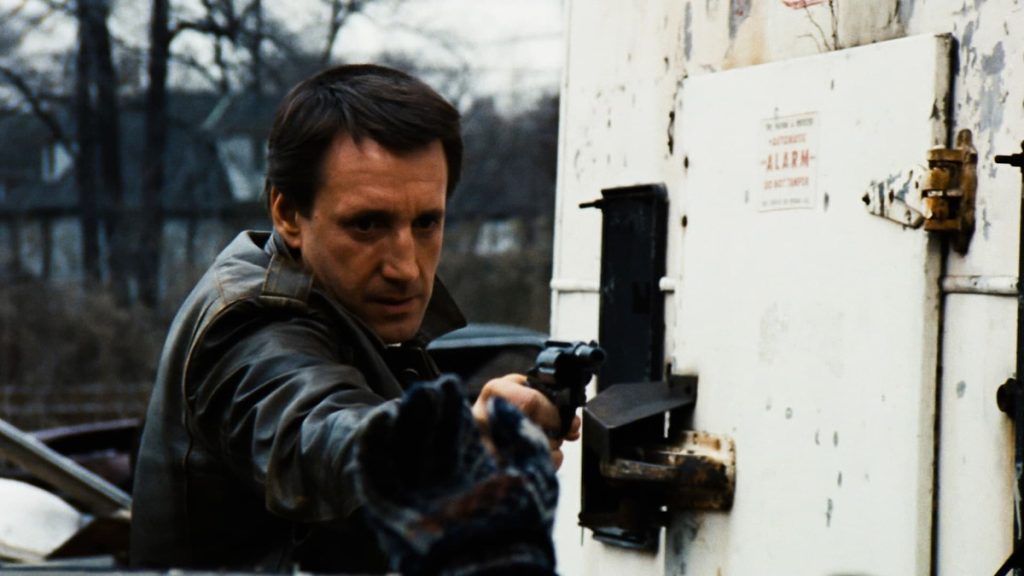Few actors appeared in as many era-defining films as Roy Scheider in the 1970s. Between his leading roles in Jaws and All That Jazz and his supporting turns in The French Connection, Klute, and Marathon Man, he was as much a distinguishing face of that decade as Gene Hackman or Jack Nicholson.
But while Hackman and Nicholson’s stars remained ascendent into the new millennium, Scheider’s sank just as the ‘80s dawned. Whether due to the legacy of bad decisions (he’d turned down Robert De Niro’s role in The Deer Hunter and Gregory Peck’s in The Omen), advancing age (he was already over forty by the time he became a leading man), or just a change in cinemagoers’ tastes (the ‘80s defined as they were by the blunt force machismo of Stallones and Eastwoods), his brief time at the top was confined completely to the ‘70s. He kept acting all the way up until his death in 2008, but the last thirty years of his career were defined by B-movie doldrums.
Still, the ‘70s were truly halcyon days for him. His first big role of the decade was as the mellower partner of Hackman’s renegade cop in The French Connection. Two years later, he scored his first lead in The Seven-Ups, which is often regarded as a spiritual sequel; both have Scheider (playing a character based on the same person), a phenomenal car chase, and a grimy NYC in common. Additionally, The Seven-Ups’ director, Philip D’Antoni, was The French Connection’s producer.
In The Seven-Ups, Scheider heads a group of undercover cops, targeting criminals likely to get jail terms of “seven years and up,” that get embroiled in an intra-mob kidnapping war.It’s a mercilessly taut film, with little time dedicated to exposition or character-building; in his first lead role, Scheider had little to back him up but his own nascent movie-starness. It’s notable that in such a pacy production, we spend precious early minutes just watching Scheider, taking him in, as he paces the sidewalk waiting to start the Seven-Ups’ latest mission.
The discrepancy between his physicality and his presence is what makes Scheider such an endlessly watchable actor. Although at five foot nine he was actually average height for an American man, he would often read short on camera. To look at, he’s all angles and straight lines; the flat knife of his twice-broken nose, his rangy limbs sharp and unyielding.
But in contrast to Hackman’s volcanic abrasiveness in The French Connection, Scheider leads from a warmer place. Like many of his ‘70s counterparts, he was neither macho nor suave. He felt things – and not just anger, either. You think of his Chief Brody in Jaws, who spends far more time terrified and out of his depth than even vaguely in control, or of his Joe Gideon in All That Jazz, whose eyes gleam with guilt throughout the whole duration, and Scheider’s ability to emit fragility is readily apparent. Just from his appearance, he suggests a life fully lived – the broken nose came from a past as a boxer – but that brought with it an empathy, an understanding. Wherever you’d been, chances are he’d been there too, and he understood. Life made the Hackmans of the world hard, but it softened the Scheiders.
The Seven-Ups understands the inbuilt, rough-around-the-edges warmth that comes with Scheider’s presence, and uses it to complement the film’s overall leanness. We don’t need any big speeches to show us how much he loves his men, it’s all there in his looks of quiet concern; an instruction to one of them to stick with another as he tails the bad guys – “Let him know he’s not alone” – is about as openly affectionate as his dialogue gets.
Scheider’s all-too-human vulnerability also gives The Seven-Ups’ epic car chase a different flavor than The French Connection’s iconic centerpiece. For almost ten solid minutes, he flies around NYC in hot pursuit of the villain that killed his friend, causing as much collateral carnage as Hackman in the earlier movie. But whereas The French Connection’s chase ends with Hackman shooting his villainous quarry to death, The Seven-Ups ends with Scheider’s escaping, as his car collides into an on-coming truck, almost decapitating him. The frenetic action literally screeches to a halt as we watch the truck driver leap out and (rather improbably, considering the severity of the accident) help a shaken Scheider to his feet. He may have lost the battle, but the war wasn’t over yet.
That image of him, beaten-up but moving ever forward, would come to define the rest of his career. Even during his few years of huge success, nothing would come easy (he had to fight off almost every leading man in Hollywood for his last great role in All That Jazz); when that success was frustratingly, irrevocably in the rearview mirror, he kept plugging on anyway.
And knowing the wasteland that was waiting right around the corner for him gives his brief spell at the top even more of a resonance. After all, few of us get to enjoy a long time in the sun, and Scheider was us. That’s why – for a brief, glorious while, at least – we couldn’t look away.

